Category: Hunting Blog
White-tailed Deer: The Impact of Drought Conditions
As deer enthusiasts and managers, we put a lot of work and time into ensuring that our deer herd is healthy. This is never an easy job, but it becomes even more difficult when nature just isn’t cooperating.
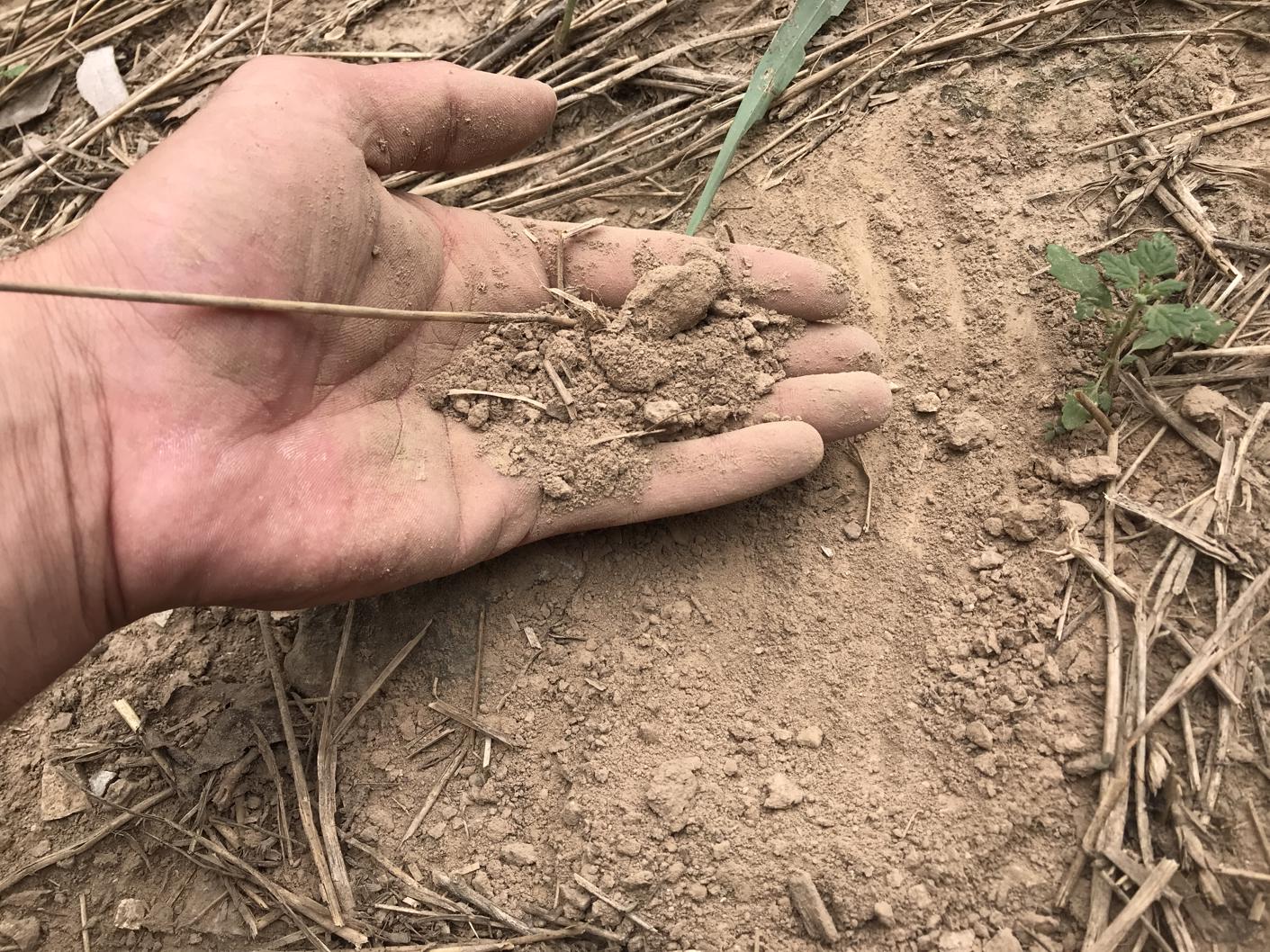
We’ve been in a wicked drought here at The Proving Grounds. We typically receive 14 inches of rain between May and July but have only gotten 7 inches during that same period this year. Plants require water for growth and deer require water for basic internal processes.
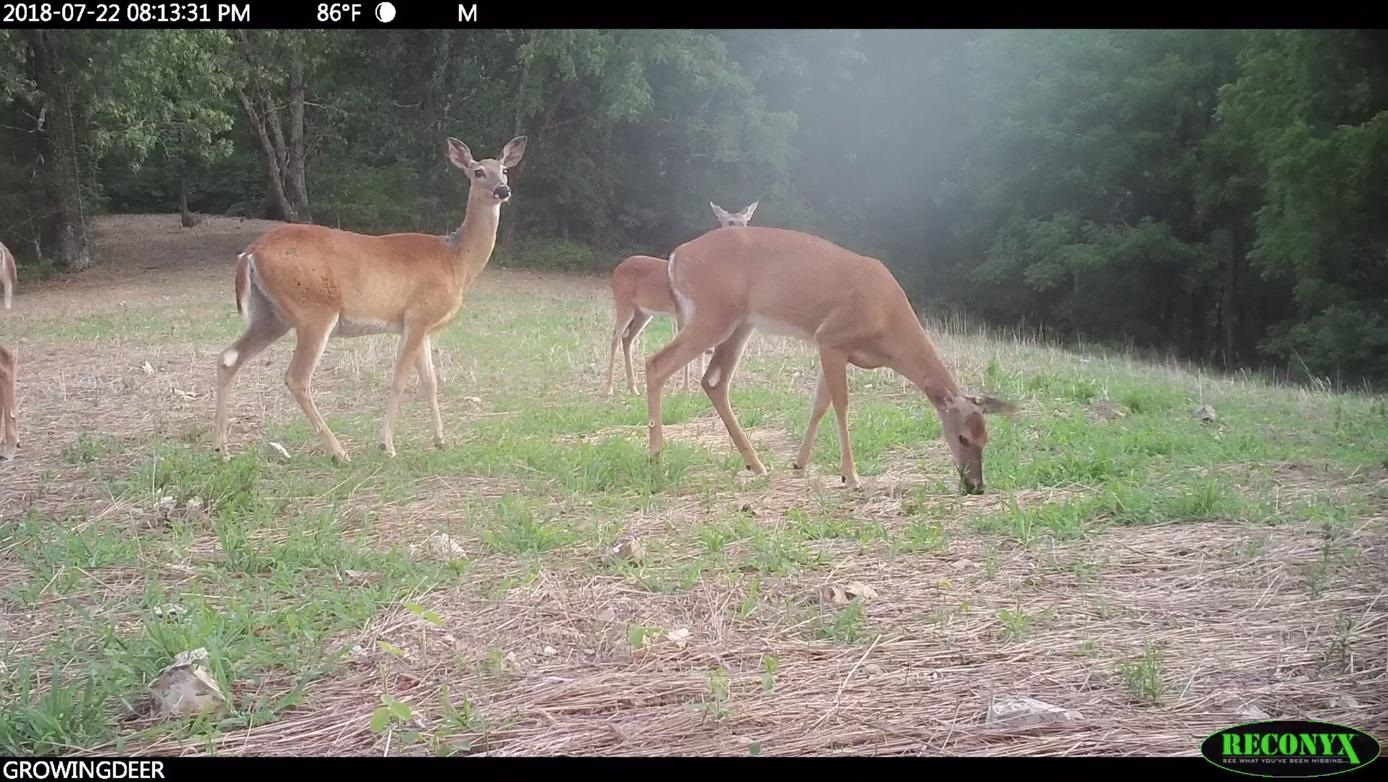
Drought has a way of compounding problems. Deer can usually acquire their water needs from forage, but during dry conditions, water from forage is often insufficient. Increased distance to water means increased energy expenditures. The more energy that a deer uses to find resources, the more it must obtain to meet basic biological needs.
Drought stunted and heavily browsed food plots add another source of stress. Under these less than ideal conditions, bucks cannot express their antler or body potential. Adult does not only have to supply their own energy needs but must also produce energy-rich milk for their fawn(s). Fawns that are born and raised during drought conditions will be at a deficit the following year compared to fawns raised in a nutrient-rich environment. Remember, deer allocate resources to maintenance (survival) processes like digestion and metabolism first, and then to production processes such as body mass and antler size.
Short of irrigating food plots, there’s only so much that managers can do to provide herds the resources they need. Drought proof water sources are excellent habitat features. It’s been so dry here at The Proving Grounds that we’ve resorted to filling kiddie pools with water across the property.
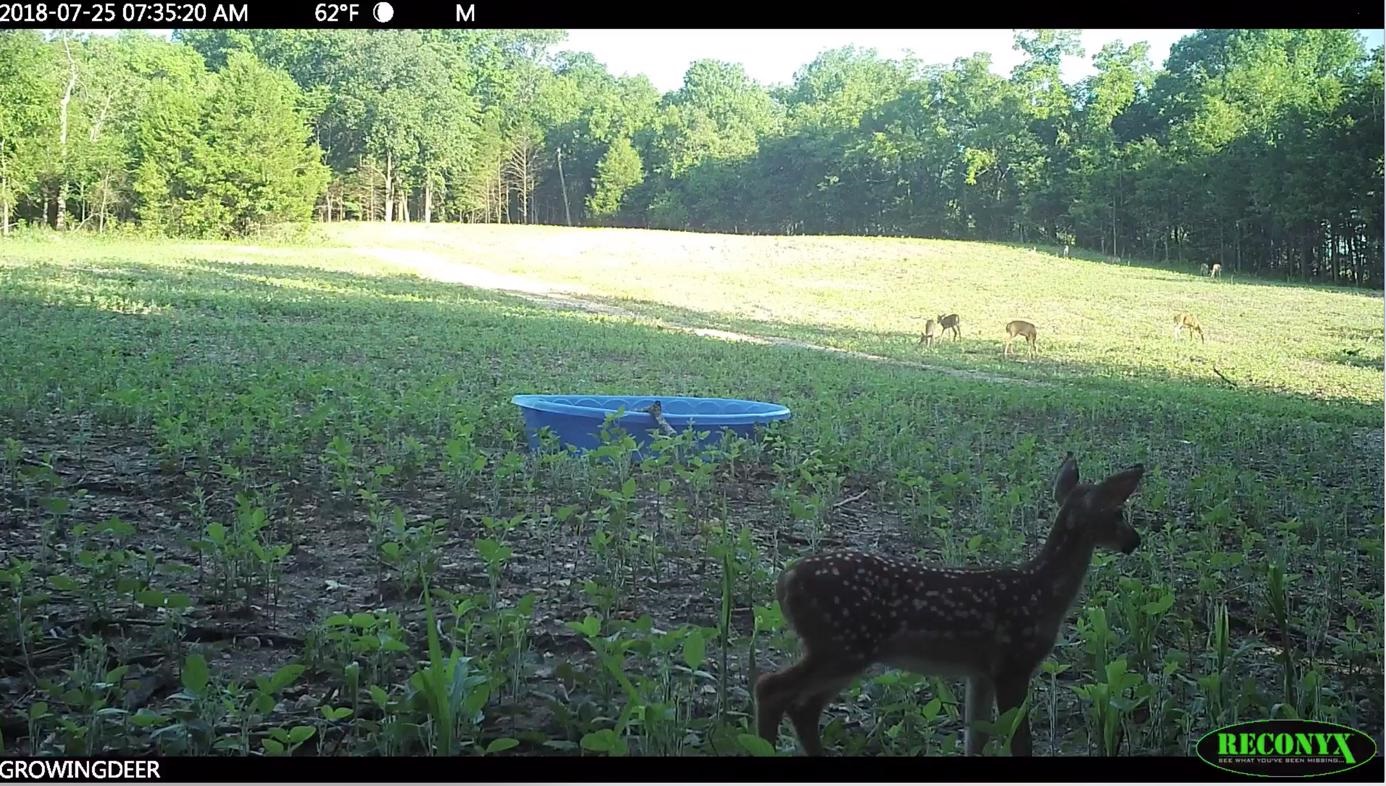
Manage your property with the bad years in mind. Develop permanent watering holes and areas of drought-resistant native vegetation. They will be the icing on the cake during good years and the life-preserver during bad years.
Grant has often reminded us that we should strive to keep deer populations in check so they thrive during tough conditions. The drought conditions here are exacerbated by having more deer than the habitat’s current carrying capacity. Stay tuned as we head into hunting season and see how our management actions pay off!
Enjoying Creation and life at The Proving Grounds,
Luke Resop
GrowingDeer intern, summer 2018
How to Develop a Strategy Now for Early Season Deer Hunting
Archery season starts here in Missouri on September 15. Some states have an even earlier archery season. We’ll be hunting in Kentucky where the season opens September 1. Even earlier than in Kentucky, August 24-26 Tennessee has a private lands only archery season before their regular archery season opens on September 22.
If you are hunting in states like these with the opportunity to deer hunt in late August or early September, now is s a great time to take the Nikons out and be watching for velvet antlers.
These early seasons are a great time to be chasing a hit list buck. The bucks will still be in their summer pattern: food to cover, cover to food, and back again. You have to be really careful because bedding areas can be really close to feeding areas. It can be tough to get in there without alerting the deer. We’ve hunted the early bow season in Kentucky for several years now with good results. Check out the hunt from 2017 in the video at this link.
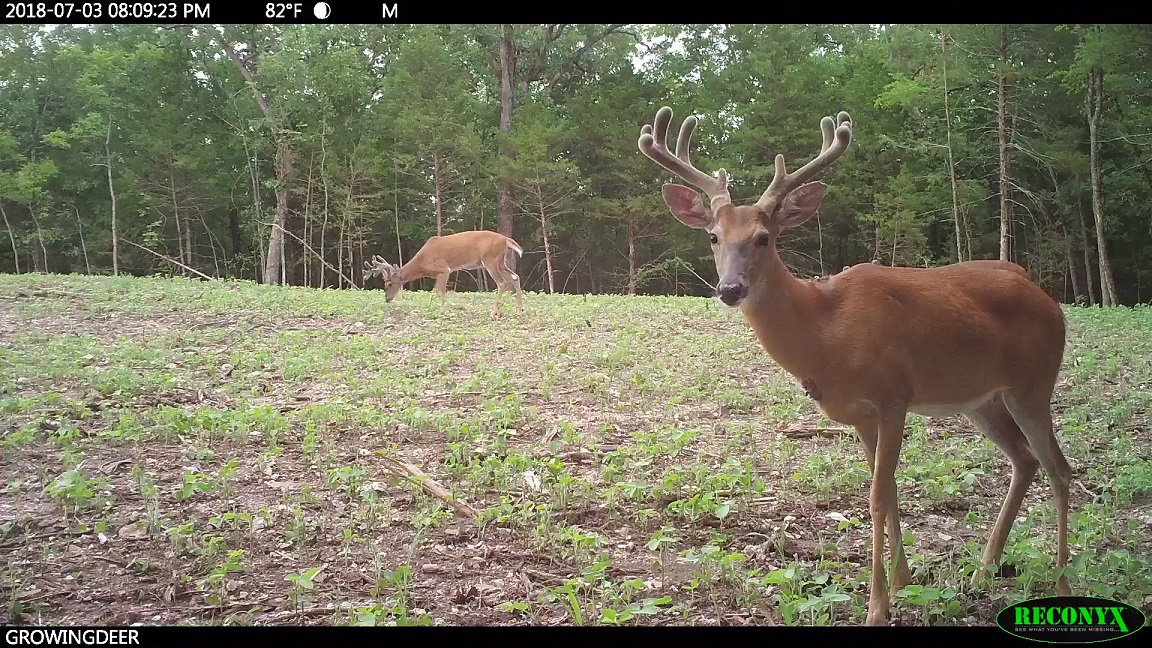
An ideal situation for early season hunts is where the bedding and feeding areas are close together but there is a crosswind that allows you to get in the stand without alerting deer.
It’s often hot in the early season so bucks typically don’t get to the food source until right at dark.
If you do some summer time scouting and find a bachelor group of bucks coming into the food plot before dark with that setup of a stand with a crosswind, you’ve got a good chance of tagging a buck in the first couple of days of the season.
Take advantage of this time when the bucks are still in their bachelor groups before the testosterone elevates and the groups disperse.
The early season can be an effective window of time to tag a hit list buck if you follow good scent control and have a strategy defined for various stand locations and wind directions. Remember the number one principle for a good stand or blind site: you need to be able to approach, hunt, and exit without alerting deer.
Watching velvet antlers and enjoying Creation,
Grant
Seven Steps to Better Food Plots
The Proving Grounds has extremely rocky and very poor quality soils with limited nutrients and soil moisture holding capacity. From the very first, I knew that no-till was the best method for planting in these soils. Here on GrowingDeer we’ve shown the changes and development of our food plot program over the years. Better soil is the result of the methods used to build and maintain the food plots.
The program has evolved into what I call the “Buffalo System” because it mimics how the great prairies were built. I’m very confident the Buffalo Food Plot System will improve soil health and produce quality forage anywhere. The Buffalo System has saved me a bunch of money and time. However, just like the results of a diet or fitness program, the results won’t occur overnight.
Here are 7 steps to get started creating better soil and better food plots using the Buffalo System:
- Take a soil test.
- Add soil nutrients as recommended by a soil test analysis.
- Terminate any existing weeds with an herbicide (glyphosate).
- Drill the fall Buffalo Blend from Eagle Seed 45 – 60 days before the first expected frost and when there’s adequate soil moisture or a forecast of rain (80% or more).
- Monitor the crop growth with a utilization cage.
- Next spring when the soil temperature is 50 degrees or higher and there’s adequate soil moisture drill Eagle Seed forage soybeans into the existing fall blend.*
- Terminate the fall crop after the beans are 2 – 4″ tall by using the Goliath crimper or herbicide (depending on presence of weeds).
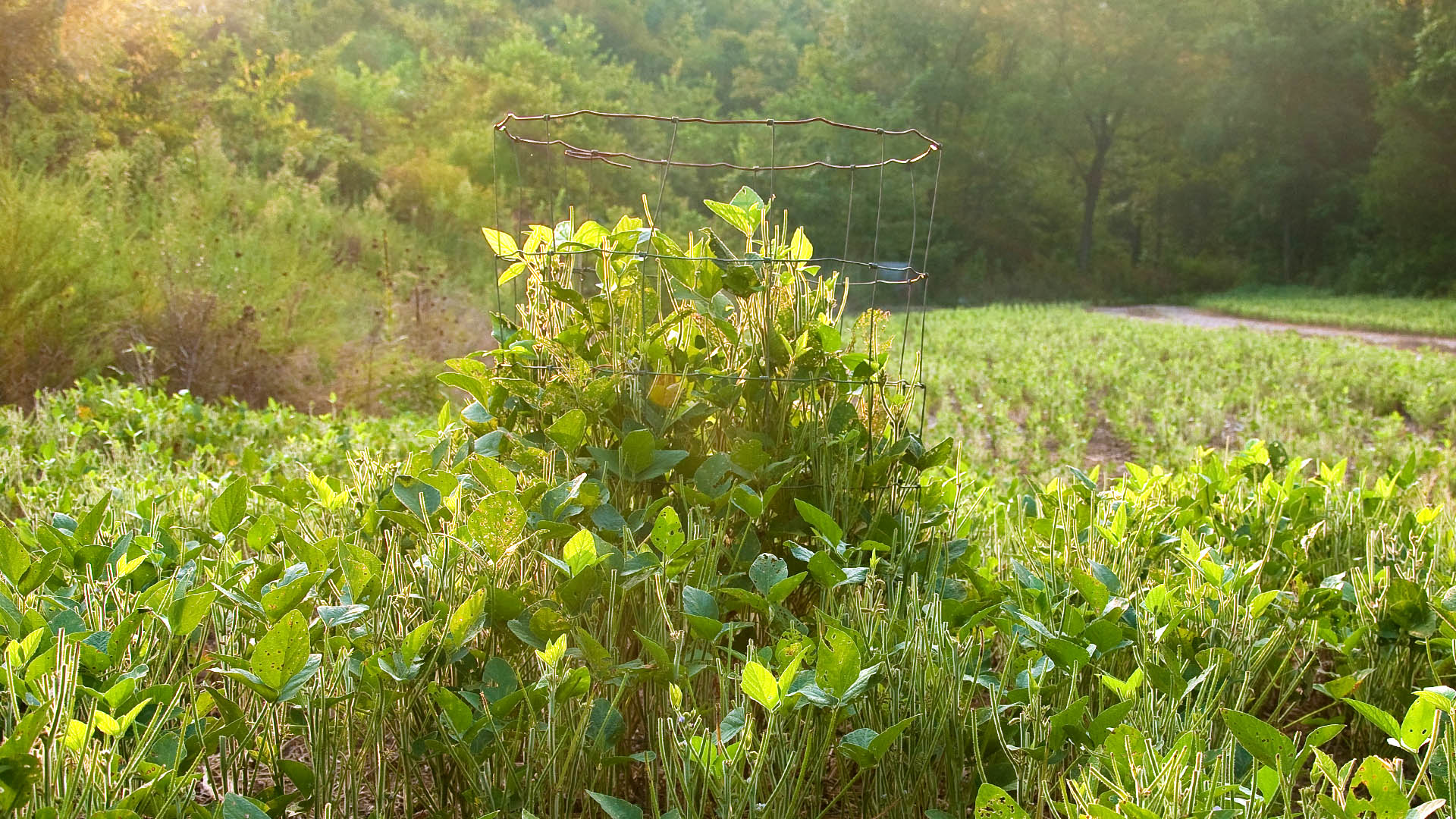
Why do I use this system? It’s because I want the biomass of terminated cover crops for weed control and slow release fertilizer. Earthworms and many other beneficial critters will convert the terminated crop to high quality fertilizer. These soil building critters prosper on year old or older biomass – not the green or fresh biomass that’s just been crimped. Therefore the more years the soil is covered with terminated forage without tillage (or fire) the faster the soil will improve due to significantly increased populations of earthworms and 1,000s of other beneficial critters.
Unless deer consume all the forage, it’s easy to build organic matter causing the plots to hold soil moisture and nutrients much better! Depending on the size of the plot and number of deer using it I plant Eagle Seed’s forage soybeans or their warm season Buffalo Blend during the spring. This rotation has worked extremely well at my place to attract deer and improve the soil quality. During the fall I plant Eagle Seeds Broadside or Fall Buffalo Blend as both are relatively drought resistant and grow in a wide variety of soils.
The Buffalo System isn’t a formula that can be used once and instant results occur. It is a scientifically sound system of forage management that will result in improving the soil’s moisture holding capacity and capturing nutrients from the air and soil. In addition, it attracts and benefits deer and other critters! This is an easy win – win. It absolutely has been a game changer here at The Proving Grounds. Remember, big antlers start in the dirt.
Growing food plots and enjoying Creation,
Grant
*I use a Genesis no-till drill and Goliath Crimper to implement the Buffalo System. These tools have allowed me to save a huge amount of time and expense of lime, fertilizer and herbicide.
Working In The Field: Interns At the Proving Grounds
Being a summer intern at The Proving Grounds requires a really tough and determined student. Why? Because working in these Ozark hills is physically challenging: hot days, ticks, snakes, chiggers and steep, rocky slopes. We let every applicant for the internships know about these tough working conditions as well as our expectations that they maintain good character. Summer interns have a normal work week of Monday through Thursday from 7:00 a.m. to 6:00 p.m. Because of this, the students that come here to volunteer their time are made of the “right stuff.”
This summer, we have been blessed to spend time in the field (and after work hours) with three young men that are passionate about deer hunting, fishing, and the outdoors. You’ve seen them appear in recent episodes of GrowingDeer. Here is a little more background info to go with the faces:
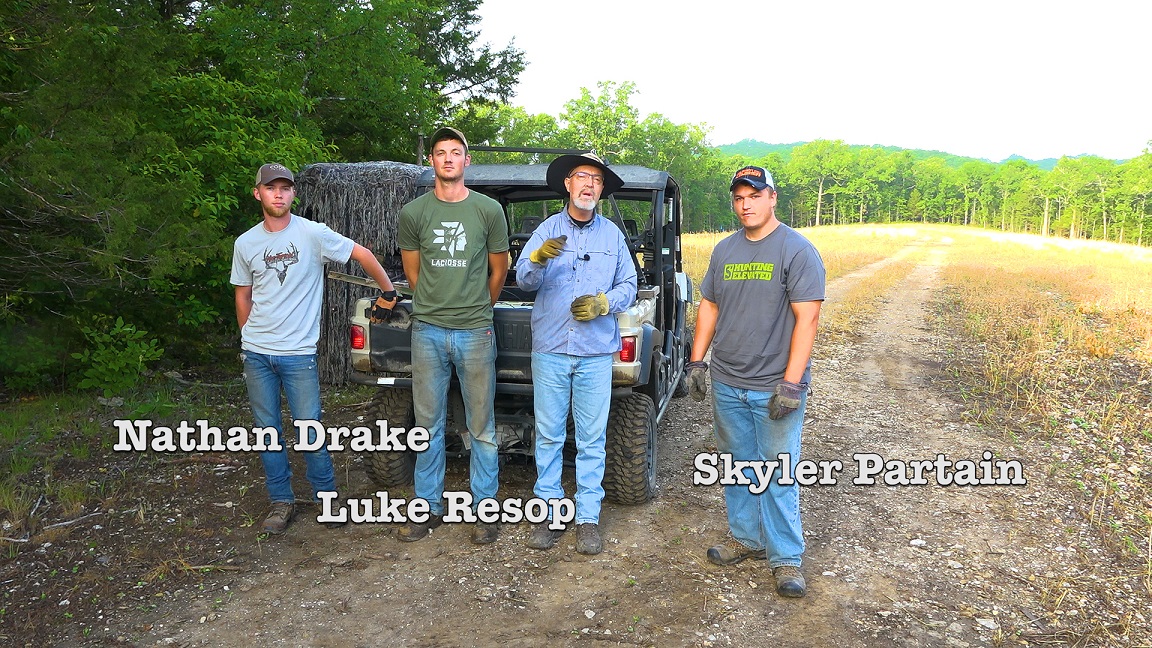
Nathan Drake attends Abraham Baldwin Agricultural College, Stafford School of Business in Tifton, Georgia. He expects to graduate in May 2019 with a degree in business. His Christian faith and love for the outdoors is the driving factor behind his internship with GrowingDeer. Nathan is studying business but loves to hunt. He killed his first deer when he was 15 years old. Nathan primarily bow hunts now. He shared that one of his favorite hunts occurred this past year when he shot a doe at 45 yards. The shot placement was great plus he had the satisfaction of the hunt occurring on a property he has helped manage. Nathan is interested in possible careers in organic farming and hydroponics.
Luke Resop attends Virginia Tech in Blacksburg, VA. He will graduate December 2019 with a degree in wildlife conservation. He has undertaken habitat restoration and improvement for the wildlife populations on the properties he hunts. Those improvements have increased the antler size and doe weights significantly. He’s now become very selective in the deer he harvests. He enjoys being in the stand, watching the deer and the challenge of field judging combined with the restraint necessary for bow hunting. His career goal is to be a whitetail biologist with a state agency or in the private sector.
Skyler Partain attends College of the Ozarks in Point Lookout, MO. He will graduate May 2019 with a Bachelor of Science in conservation and wildlife management and a minor in ag business. Skyler enjoys deer hunting and sharing the experience with friends and family. His first deer was taken when he was hunting with his grandfather. He remembers that hunt well not only because it was his first deer but also because in those final moments before the shot his grandfather accidentally dropped his coffee thermos from the stand. Instead of running off, the buck that was in front of them “froze” and Skyler was able to make the shot. His career goal is to work either as a private lands biologist with a state/federal agency or something related to habitat management for wildlife.
After the long hot days here on the property, you’ll most often find these guys out kayaking and fishing the nearby lakes. They are living the dream – much like Luke Bryan sings about: “huntin’, fishin’ and lovin’ every day…”.
We hope that you find some time to sit “high on a hill looking at a field*” and enjoy some time with the Creator.
Enjoy Creation,
Tracy Woods
For the GrowingDeer Team
*This verse of the Luke Bryan song has the field downwind but Grant and the team prefer to have the wind in their face (upwind) to watch the deer in the field while sitting on that hill or in the stand! No matter which way the wind blows, we’re lovin’ the days and lovin’ the Creator!
Summer Scouting with Trail Cameras
Here at The Proving Grounds we keep our Reconyx trail cameras out year round. We just love seeing critters! If you don’t keep you trail cameras out during the entire off season – now is the time to get them into the woods. This time of the year is perfect for scouting and capturing developing velvet antlers!
Many bucks have enough growth that they are now able to be identified by unique antler characteristics. Plus, many fawns are on the ground and it is a great way to monitor recruitment numbers.
Here are five great locations to put your trail cameras:
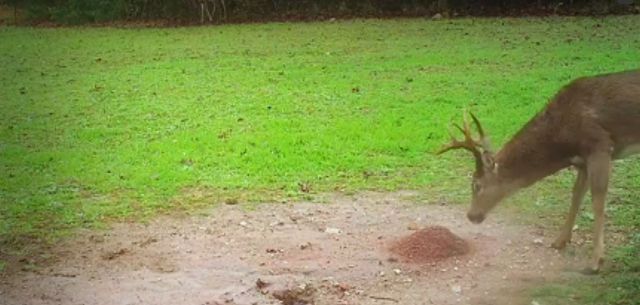
- Over mineral sites (in areas where this is legal).
- On high quality food sources (such as Eagle Seeds Forage soybeans).
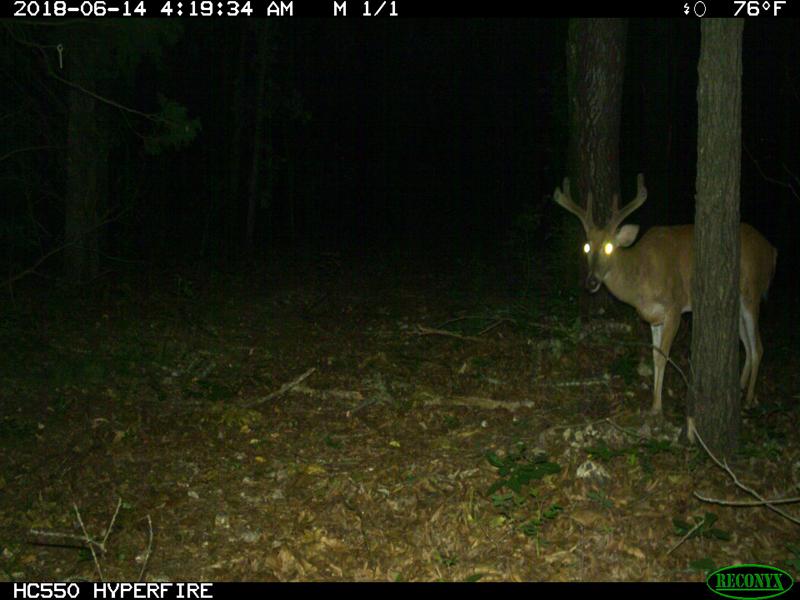
- On active trails.
- Make sure to place your trail camera perpendicular to trails so you can get a broadside picture to estimate age.
- On/in bottlenecks – natural (edge habitat) or manmade.
- The corners of Hot Zone fences make great bottlenecks for deer to hug the corner/edge of the fence.
- If in drought conditions, water can be a hot attraction.
To make sure you get the most out of your trail cameras, follow these tips:
- Place cameras in low disturbance areas: on the edge of interior roads or food plots etc. (Easy in and out.)
- Use scent control practices when checking cameras. Our team reduces our scent by using D/Code field spray and wearing rubber-bottomed LaCrosse boots.
- Realize that the activity captured now may not reflect fall activity.
- Food sources will change during hunting season.
- Bucks will likely shift within their home range after summer.
It won’t be long before we begin developing this season’s hit list. As always, we’ll be sharing the Reconyx pictures as the velvet antlers start to harden. As you get trail camera pictures, we hope that you will share them with us on social media: Facebook, Instagram, or Twitter.
Watching for velvet antlers and enjoying Creation,
Daniel
Improving And Maintaining Fawning Habitat
Recently, while cutting cedars in a bedding area, Skyler Partain, one of our summer interns, found a fawn nestled in the native vegetation. Not only was it a neat encounter for Skyler, but it was a reminder of the benefits of improving habitat.
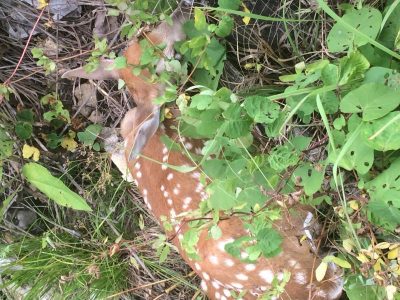
The area where Skyler and the rest of the crew were cutting was a bedding area that was once covered in cedars. Many years ago, we felled the cedars, waited several years until the cedars were dry, and used prescribed fire to stimulate native grasses and forbs. With the cedar canopy removed, native grasses and forbs began to grow. Seeds of these native species were in the soil and their populations exploded once released!
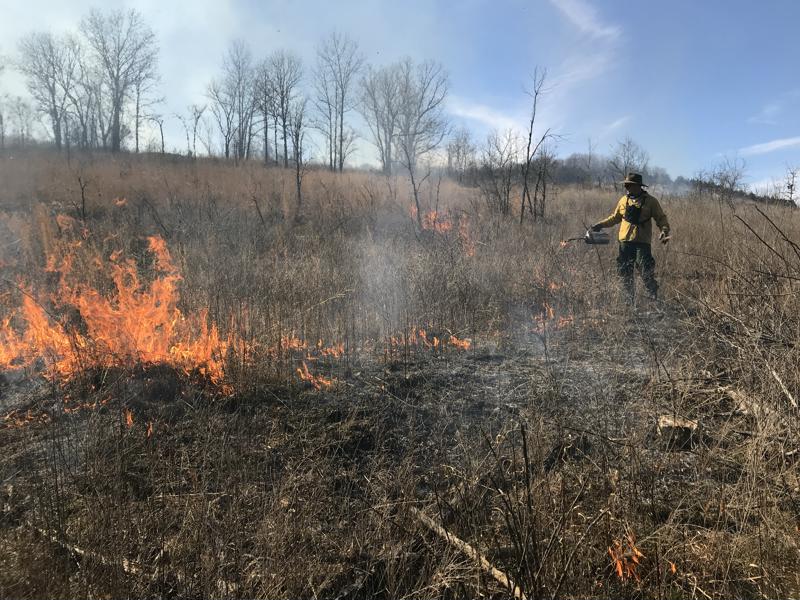
The diverse native grasses and forbs now provide high-quality forage for deer of all ages and ideal fawning habitat. Fawns are now effectively able to hide from hungry predators, such as coyotes. Before, the “best” cover was cedar and mature hardwoods. Much of the ground was bare under the cedar canopy which made it an easy place for predators to find fawns and poults.
A little chainsaw work resulted in substantially improved cover for deer, both adults and fawns. We continue to maintain these native vegetation areas with prescribed fire and occasionally use chainsaws to remove encroaching cedars. The benefits speak for themselves. We now see lots of fawns and enjoy many encounters with deer throughout the entire year!
I hope you are able to get out this summer and improve the habitat where you hunt. You’ll be glad you did!
Improving habitat,
Daniel
Turkey Hunters: How To Encourage a Quality Turkey Population
Each spring, when the strutters begin their dance and gobbles echo through the hollers, we get excited because we know turkey season is just around the corner! However, the number of turkeys there are to chase is influenced by many factors. As wildlife managers there are several things that we can do to help encourage healthy populations. There are also factors that are beyond our control.
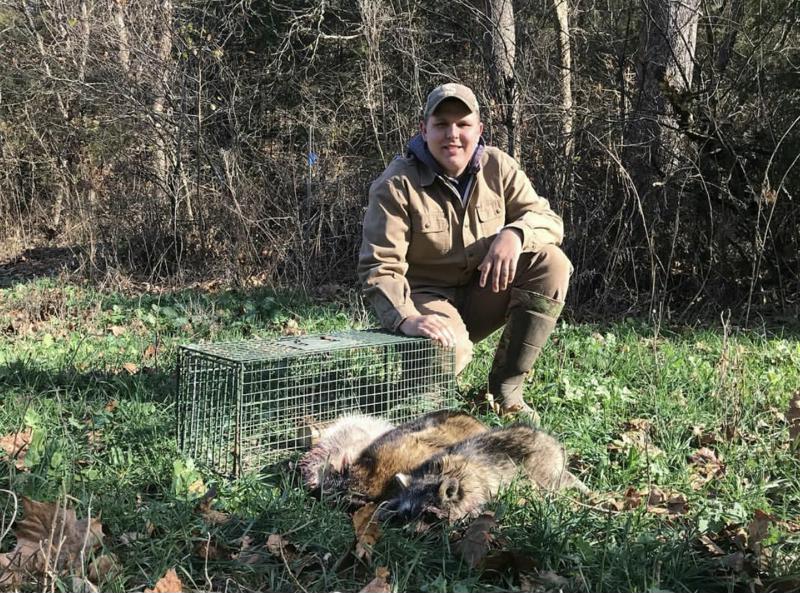
Each winter we use Duke cage traps to remove 50+ raccoons and opossums which are notorious turkey nest predators. By reducing the number of hungry predators, turkey eggs have a better chance to hatch and mature if the conditions are favorable.
Another way we help encourage a successful hatch is by providing high quality habitat. We use prescribed fire during the late winter months to create ideal nesting habitat for the spring.
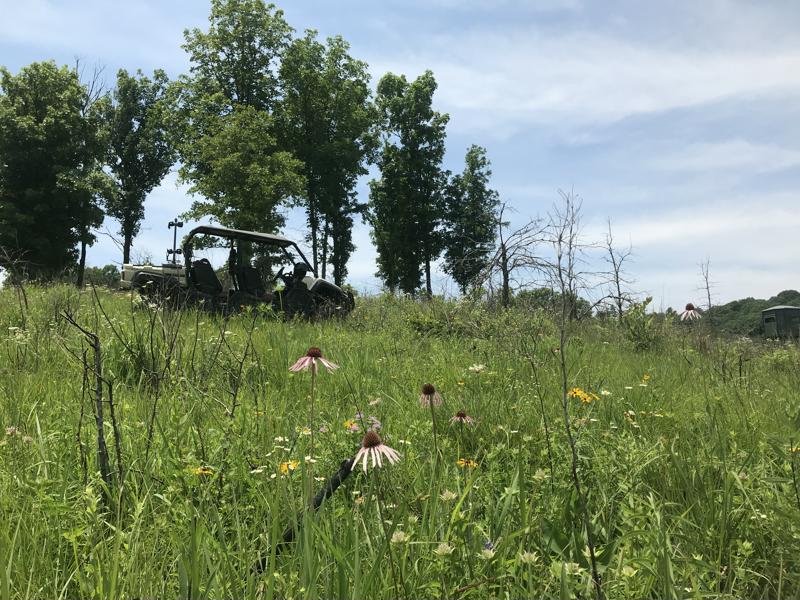
The results following the prescribed fire are incredible! Native grasses and forbs are great for nesting and brood habitat. Hens can raise their heads above the vegetation and look for predators. This type of habitat is also a great bugging area for hens, so they can feed and nest in the same area.
With fewer predators in the area and quality habitat, hens and poults have the ability to express their potential.
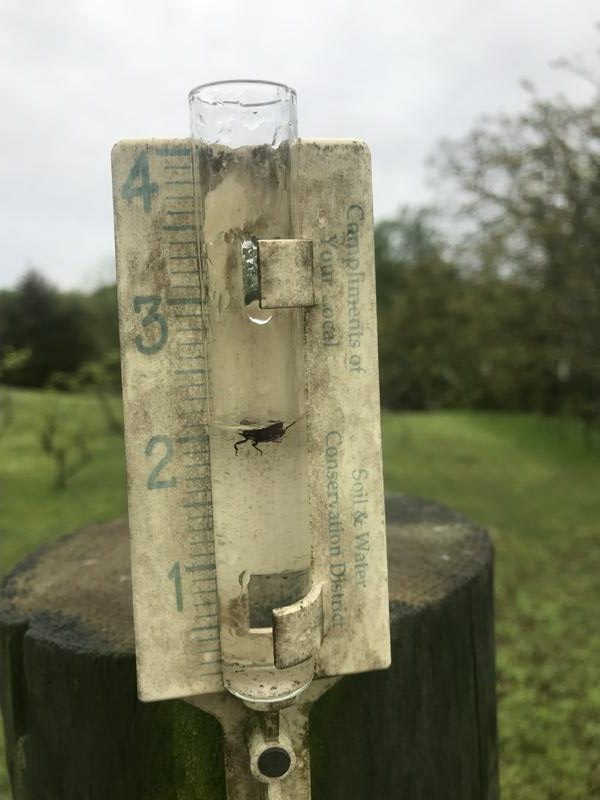
However, rain is often an influencer of turkey numbers. Timely spring rains can destroy turkey nests or result in the death of young poults.
This spring we had several heavy rains during prime nesting season. We suspect that many nests were destroyed. We have not seen many poults and are now seeing another spike in turkey breeding behavior. Hens are likely re-nesting which will result in a later hatch.
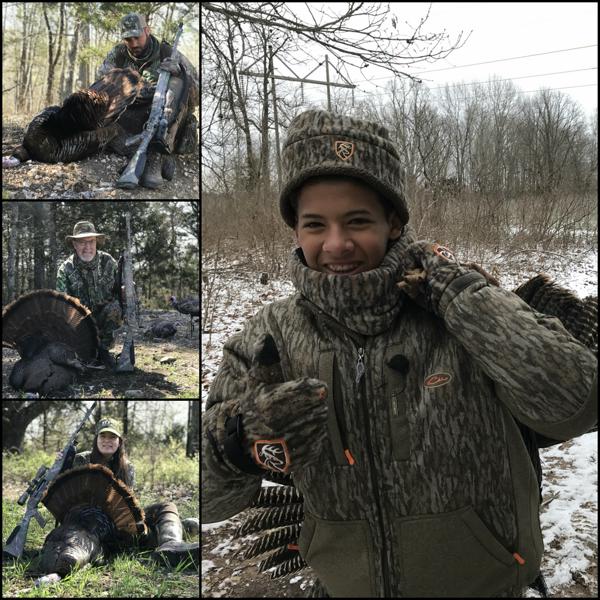
We can’t control all the factors, but as managers we can do our part to encourage healthy populations so there are plenty of longbeards to chase each spring!
Dreaming of future turkey hunts,
Daniel
Why Exclude Deer From a Portion of a Food Plot?
For years I’ve used Hot Zone fences to protect some soybeans from being browsed during the growing season. I’m commonly asked, “Why do you plant a food plot only to use a Hot Zone fence to exclude deer?”
The answer is simple: I wish to allow some beans to express their full potential and make as many pods as possible. Beans that are browsed throughout the growing season won’t make as many pods as they could.
Eagle Seed soybean pods are very attractive to deer, especially during the late season when it’s cold. Some food plots are small enough that deer will likely browse every plant during the growing season.
Just excluding deer isn’t the best strategy. With some planning based on the following questions, a hot spot can be created:
• Can the area be approached, hunted, and exited without alerting deer?
• Would it be better to remove the entire exclosure or just one side to create a bottleneck?
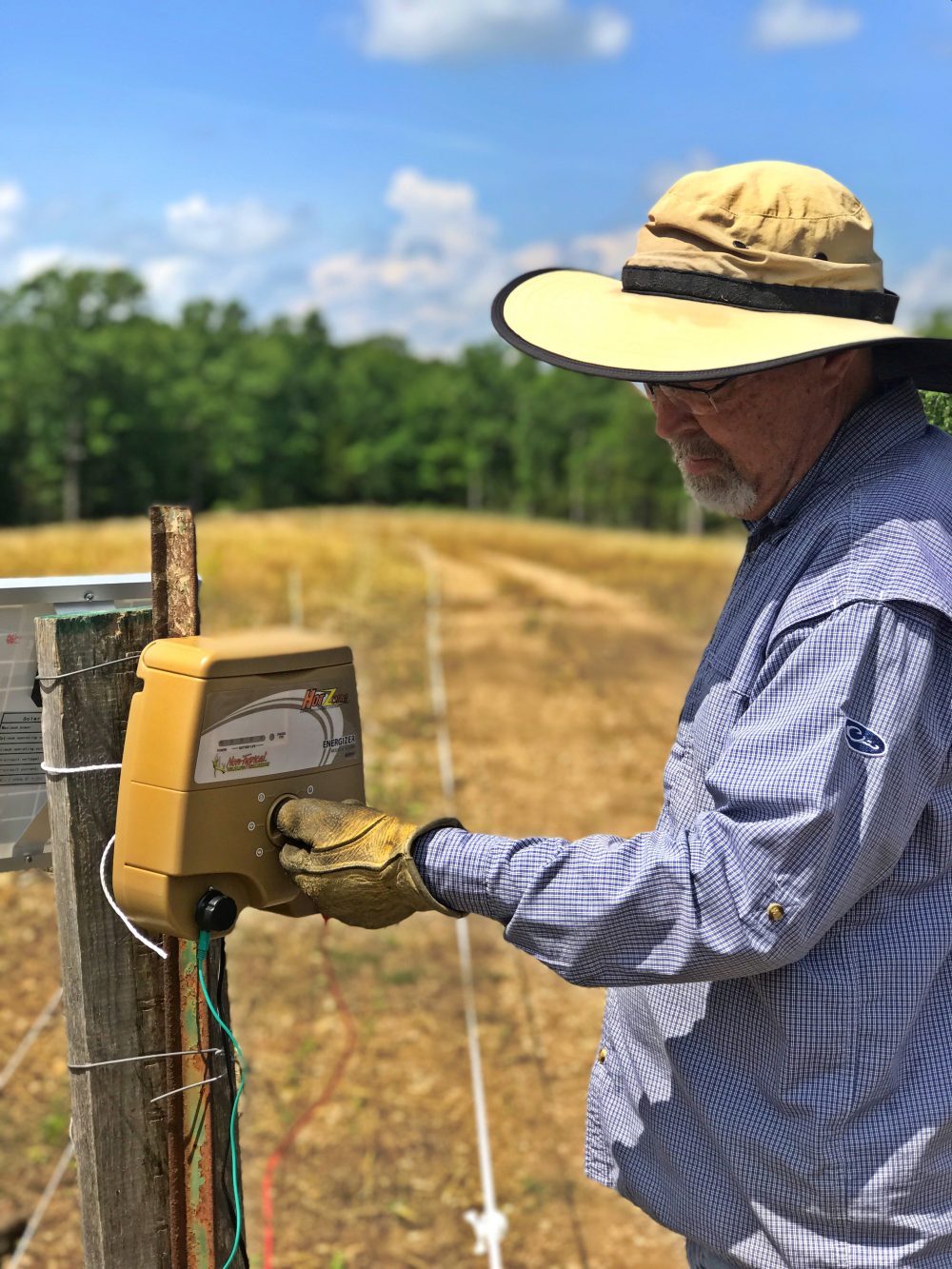
By protecting all or a portion of the soybeans in a plot they will make as many pods as the conditions allow. Then create a gap in the fence or take it down when it’s time to hunt.
Here are some tips for using a Hot Zone:
• Always keep the fence charged! Deer will lose fear of a fence that doesn’t have a charge.
• Weed eat or terminate any vegetation touching the fence to reduce the chances of a short and draining the battery.
The Hot Zone allows hunters anywhere to have the fun and success common to those hunting in ag production by protecting soybeans even in a small plot. It also allows hunters in ag production areas to have standing beans to hunt after the commercial crops have been harvested!
Enjoy Creation,
Grant
Food Plots and Hot, Naked Soil
The daytime temperatures are forecast to be in the 90s much of next week at The Proving Grounds. These high temperatures are tough on critters.
The problems deer experience during warm temperature are compounded when forage is also stressed. The weather can’t be controlled but we can reduce the impacts of stress to forage caused by heat.
Most forage varieties can thrive in high heat if there’s adequate soil moisture. It’s not practical to irrigate most food plots. However, it is possible to manage food plots in a way to conserve the available soil moisture.
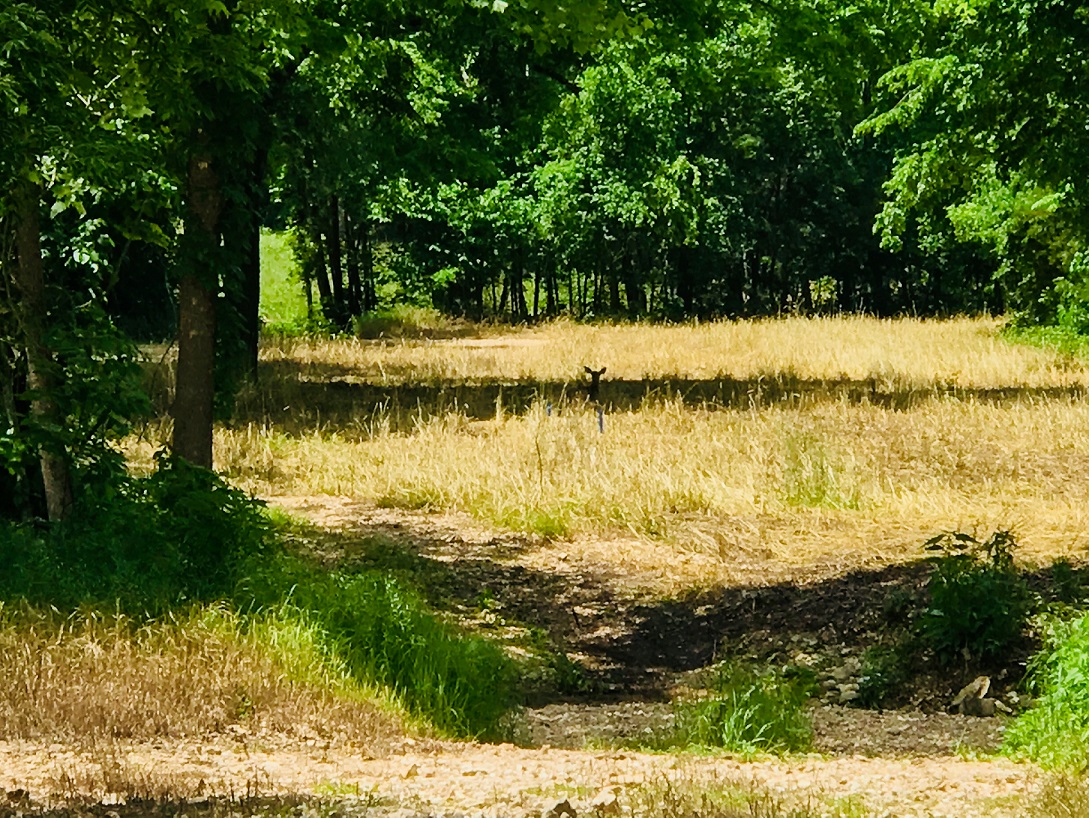
Soil moisture is primarily lost through evaporation and plants lose moisture through transpiration (loss of moisture through pores). Researchers have studied the impacts of heat on soil moisture loss and the numbers are enlightening. The following data is from the NRCS publication at this LINK.
They reported the following for surface soil temperatures:
- At 70 degrees soil temperature, 100 percent of the soil moisture is used for plant growth.
- At 86 degrees, soil microbial activity begins to decline.
- From 95 to 113 degrees, 15 percent of soil moisture is used for plant growth and 85 percent for ET.
- At 113 degrees, soil bacteria start to die.
- At 130 degrees, 100 percent of soil moisture is lost through ET.
- At 140 degrees soil bacteria, the genesis of the soil biology, die.
What’s an easy way to reduce surface temperatures of soil exposed to the sun? Add shade! That’s exactly what we’re doing when we use the Goliath Crimper to terminate crops. The crimped vegetation becomes mulch that shades and reduces the soil’s surface temperature!
You’ve probably raked back some mulch in a garden or a wad of leaves, etc., and noticed there was more moisture there than in soil that was exposed to the sun.
Ensuring the soil is always covered conserves moisture and reduces stress on forage. This results in healthier deer and larger antlers. This is another reason the Buffalo System of forage management produces better crops and cost less than conventional till and bare the soil practices.
I encourage you to consider the benefits of the “Buffalo System”. I’ll be sharing more food plot strategies and techniques in future videos and blogs.
Growing deer, food plots and enjoying Creation,
Grant
Why Worms Are Valuable for Food Plots
Implementing the Buffalo System in food plots allows several natural processes to literally create high-quality soil. One of the most important and productive processes is when the crimped forage decays providing food for earthworms. The more worms in the soil, the quicker the soil is built. Worms not only make soil – they are much better at tilling soil than any mechanical device.
Research indicates that worms “can eat their weight in dirt each day. One acre of soil may contain up to one million worms. Those worms can produce around 700 pounds of castings each day. The castings contain nitrogen and other nutrients essential for plant growth. Worm compost improves soil structure and drainage while increasing nutrients.” Worms also till the soil by mixing layers and creating tunnels, helping air and water reach plant roots.
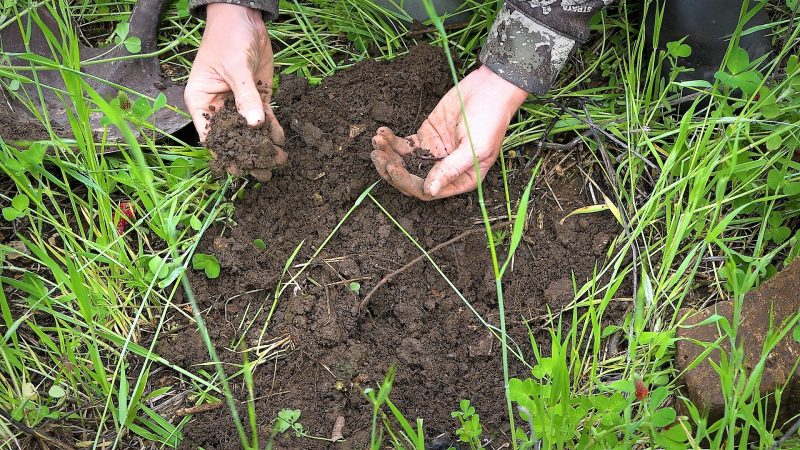
Think on that fact: 700 pounds of castings a day! That’s a valuable addition on many levels! A 5-pound bag of worm castings at a garden center can cost well over $10! Being a worm farmer is financially rewarding! The presence of earthworms are extremely valuable to food plot farmers!
In some respects, establishing food plots using the Buffalo System means that I am now a worm farmer. Monitoring worm populations (see 16:08 in this video) will be an important indicator of how well the soils are developing at The Proving Grounds.
GrowingDeer, food plots, and worms, and enjoying Creation,
Grant



